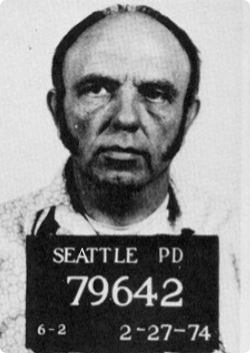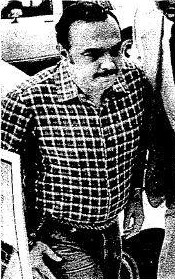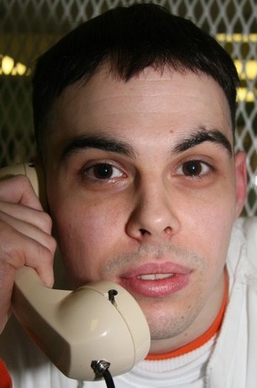
The United Federated Forces of the Symbionese Liberation Army was a small, American far-left militant organization active between 1973 and 1975; it claimed to be a vanguard movement. The FBI and wider American law enforcement considered the SLA to be the first terrorist organization to rise from the American left. Six members died in a May 1974 shootout with police in Los Angeles. The three surviving fugitives recruited new members, but nearly all of them were apprehended in 1975 and prosecuted.

Bethel is a city in Bethel Census Area, Alaska, United States. It is the largest community on the Kuskokwim River, located approximately 50 mi (80 km) upriver from where the river flows into Kuskokwim Bay. It is also the largest city in western Alaska and in the Unorganized Borough, as well as the eighth-largest in the state. Bethel has a population of 6,325 as of the 2020 census, up from 6,080 in 2010.

Matricide is the act of killing one's own mother.

Emily Harris was, along with her husband William Harris (1945–), a member of the Symbionese Liberation Army (SLA), an American left-wing terrorist group involved in murder, kidnapping, and bank robberies. In the 1970s, she was convicted of kidnapping Patty Hearst.

Robert Christian Hansen, known in the media as the Butcher Baker, was an American serial killer. Between 1971 and 1983, Hansen abducted, raped, and murdered at least seventeen women in and around Anchorage, Alaska; he hunted many of them down in the wilderness with a Ruger Mini-14 and a knife. He was arrested and convicted in 1983, and was sentenced to 461 years without the possibility of parole. He died in 2014 of natural causes due to lingering health conditions at age 75.
On March 5, 2001, a school shooting occurred at Santana High School in Santee, California. The gunman, 15-year-old Charles Andrew Williams, opened fire with an eight-shot .22-caliber revolver, killing two students and wounding 13 others. Williams was then apprehended by responding police officers and convicted. He is currently serving 50 years to life in prison.
The Parker Middle School dance shooting was an incident that occurred on April 24, 1998 at a banquet facility in Edinboro, Pennsylvania, United States. Andrew Jerome Wurst, 14, fatally shot 48-year-old John Gillette, and wounded another teacher and two students at Nick's Place during an 8th grade dinner dance.
The Richland High School shooting was a school shooting that occurred on Wednesday, November 15, 1995, in Lynnville, Tennessee, a small community located in Giles County. Seventeen-year-old James Ellison "Jamie" Rouse, a senior student at the school, killed one teacher and one student, and seriously wounded another teacher.

Spring Creek Correctional Center is an Alaska Department of Corrections maximum security prison for men located in Seward, Alaska, United States. The prison is located approximately 125 miles (201 km) south of Anchorage. The prison is located on about 328 acres (1.33 km2) of land surrounded by national parks. The prison capacity consists of over 500 inmates and 97 correctional officers. Built as a decentralized campus, the prison construction was completed in 1988 at a cost of $44,678,000. A large portion of the prisoner population consists of "hard core" felons who committed violent crimes, such as murder. The Alaska DOC says that these prisoners "will probably spend the rest of their life in prison." Spring Creek also houses prisoners who committed less serious crimes like assault and burglary and usually have sentences from three years to ten years.
In the United States, life imprisonment is amongst the most severe punishments provided by law, depending on the state, and second only to the death penalty. According to a 2013 study, 1 of every 20,000 inhabitants of the U.S. were imprisoned for life as of 2012. Many U.S. states can release a convict on parole after a decade or more has passed, but in California, people sentenced to life imprisonment can normally apply for parole after seven years. The laws in the United States categorize life sentences as "determinate life sentences" or "indeterminate life sentences," the latter indicating the possibility of an abridged sentence, usually through the process of parole. For example, sentences of "15 years to life," "25 years to life," or "life with mercy" are called "indeterminate life sentences", while a sentence of "life without the possibility of parole" or "life without mercy" is called a "determinate life sentence". The potential for parole is not assured but discretionary, making it an indeterminate sentence. Even if a sentence explicitly denies the possibility of parole, government officials may have the power to grant an amnesty to reprieve, or to commute a sentence to time served.
The Thurston High School shooting occurred on May 21, 1998, at Thurston High School in Springfield, Oregon. 15-year-old freshman student Kipland Kinkel, who had been scheduled to appear at an expulsion hearing the day prior, murdered his parents before killing two of his classmates and wounding 25 others. The shooting ended when a group of students managed to subdue Kinkel, leading to his arrest. Kinkel pled guilty to murder and attempted murder and was sentenced to 111 years in prison without the possibility of parole. He is currently incarcerated at the Oregon State Correctional Institution.
Since the 1994 film Natural Born Killers was released, several attacks suspected to be copycat crimes have been committed by fans of the film, mostly by high school students within the age range of 15 to 18. Though apparent links have been claimed between the film and most of the incidents described below, certain causality has not been proven.
Sara Jessimy Kruzan is an American activist and survivor of child sex trafficking. In 1995, at the age of 17, she was convicted of the first-degree murder of her trafficker, George Gilbert Howard, who began to groom her for the sex industry at the age of 11. She was initially sentenced to life imprisonment without parole, but was later both paroled and pardoned.

Harvey Louis Carignan is an American serial killer serving a life sentence at the Minnesota Correctional Facility – Faribault for the murders of two women. He had been previously convicted for a 1949 rape and murder he committed while stationed in the U.S. Army, in Anchorage, Alaska.

Rufe Persful was an American criminal, convicted for murder, kidnapping and robbery. He was considered one of the most dangerous criminals of his era by the authorities. Convicted of the murder and robbery of an elderly man at the age of 18, he was sentenced to 15 years in Arkansas State Penitentiary, but unlike a standard prison, it involved farm labor. He was given the task of shooting fellow inmates with a shotgun if they attempted to escape. He killed and disabled many prisoners during his time at the Arkansas Penitentiary, punctuated by periods of parole as a reward for his prison protection, and then re-offending and being sent back to resume his role. In December 1934, Persful was convicted for kidnapping and robbery in Paragould, Arkansas and sentenced to 20 years, after which he was transferred to United States Penitentiary, Atlanta. Two inmates recognized him from Arkansas and word spread of his killing of fellow inmates and he began being severely abused. He was transferred to Alcatraz Federal Penitentiary a year later but was recognized and continued to be tortured by his fellow inmates because of his past offenses. In 1937, Persful attempted to cut off his hands in sheer desperation of his experiences at Alcatraz and was diagnosed with schizophrenia. He was eventually sent to McNeil Island Penitentiary, where he was again recognized and suffered much abuse from his fellow inmates, despite being heavily watched over by the prison staff. Persful was released in April 1948 and moved in with a relative in Gary, Indiana, never to be convicted of a crime again.
Bethel Regional High School (BRHS) is a public high school in Bethel, Alaska, and part of the Lower Kuskokwim School District (LKSD). As of August 2013 it had an enrollment of 500. As of 2018 it is the LKSD school with the highest enrollment.
Charles L. Meach, III (1948–2004) was a mentally ill American murderer who killed five people in Alaska.

Joseph Ernest Atkins was an American serial killer and Vietnam War veteran who murdered three people in South Carolina. He murdered his half-brother in 1969 and received a life sentence. After Atkins’ adoptive father pleaded with officials for his release, he was released on parole in 1980. In 1985, Atkins murdered a 13-year-old neighbor girl and his adoptive father. Atkins was convicted of these two murders, sentenced to death, and executed in 1999.
Randy William Gay is an American serial killer who killed three people, including his father-in-law and his biological father, with a shotgun during arguments between 1978 and 2011. He served time in prison for each of the first two murders, and was sentenced to death for the third murder.

Michael James Perry and Jason Aaron Burkett were American spree killers who killed three people in Texas in 2001. They were both tried and convicted of capital murder for the killings. Perry was sentenced to death and executed in 2010, while Burkett received a life sentence. Their cases were later the subject of Werner Herzog's 2011 documentary, Into the Abyss.










